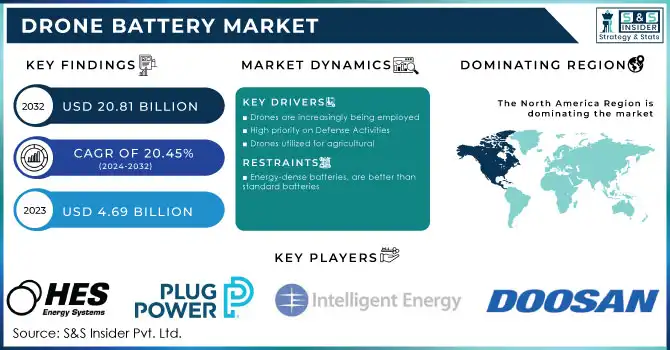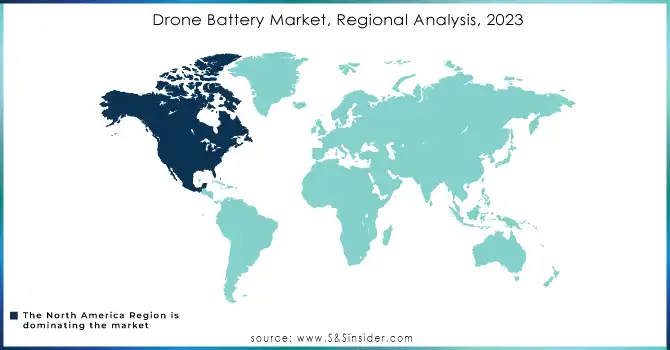Drone Battery Market Key Insights:

To get more information on Drone Battery Market - Request Free Sample Report
The Drone Battery Market size was USD 4.69 billion in 2023 and is expected to reach USD 20.81 billion by 2032, growing at a CAGR of 20.45% over the forecast period of 2024-2032.
Key players in the market are focused on developing drones that have a long flight, high-capacity, and are equipped with state-of-the-art technology. The growing global e-commerce industry and the growing acceptance of drones in it are expected to further the demand for high-performance hybrid drones. This is expected to boost the market growth of drone batteries in the forecast period.
KEY DRIVERS:
-
Drones are increasingly being employed
-
High priority on Defense Activities
-
Drones utilized for agricultural
-
Law enforcement offer by Drones
RESTRAINTS:
-
Energy-dense batteries, are better than standard batteries
-
Extremely expensive Cost
-
Market adoption is sluggish and limited
-
Adoption of newer batteries
OPPORTUNITIES
-
Low-Cost Microprocessors
-
Extend battery life and
-
Enable real-time monitoring
CHALLENGES:
-
Lack of safety regulations
-
the batteries are vulnerable to phenomena such as thermal runaway
-
Overcharging might cause batteries to explode
-
Drone batteries are more susceptible
THE IMPACT OF COVID-19
COVID-19 has significantly disrupted almost all industries including infrastructure, retail, manufacturing, and more. To combat the COVID-19 epidemic, many countries have used roadblocks and are now simplifying them in terms of phases and industry strategies.
During the epidemic, increasing demand for UAVs in health care systems has led to the growth of the UAV battery market. To kill germs in public places and to contain the spread of COVID-19, many health care organizations use UAVs to perform various functions such as spraying antibiotic. These inflatable UAVs are packed with disinfectant and cover a large area in less time and 50 times faster than conventional means.
Segmentation
The drone battery market has been divided into three categories based on technology are lithium-ion, nickel-ion, and fuel cell-ion.
During the forecast period, the lithium-based segment is expected to lead the market. Advances in lithium-metal and lithium-sulfur technology will propel the lithium-based technology segment forward. Increased demand for alternative modes of transportation is driving demand for autonomous urban air mobility, which is driving demand for fuel cell batteries in drones.
The drone battery market is divided into three components cells, battery management system enclosures, and connectors.
Because of the increased emphasis on monitoring important parameters of batteries such as current, voltage, temperature, state of health, and state of charge, the battery management system segment is expected to grow at the fastest CAGR.
The drone battery market is divided into two categories based on point of sale original equipment manufacturers (OEM) and aftermarket.
The aftermarket segment is expected to grow at the fastest CAGR during the forecast period, owing to rising demand for the modification and upgradation of commercial and military drones, which is propelling the growth of the aftermarket segment globally. When you buy a drone, it usually comes with 1–2 batteries. However, it is recommended that additional batteries be purchased to meet the industry's flight demands. As a result of increased demand for longer flight times, the spare battery management segment of aftermarket services will grow.
The drone battery market is divided into four segments based on platform: consumer, commercial, government & law enforcement, and military.
The military sector is expected to lead the drone battery market due to increased defence sector investments in unmanned aerial systems and the growing importance of intelligence, surveillance & reconnaissance, combat operations, and battle management applications. Drone batteries of various sizes and capacities are used in the military. HES Energy Systems, Plug Power, EaglePicher, Inventus Power, and Oxis Energy Ltd. are a few companies that cater to this market.
The drone battery market is divided into three categories: fixed-wing, fixed-wing VTOL, and rotary wing.
Because of the high stability and endurance of fixed-wing drones in commercial and civil applications, the fixed-wing segment is expected to lead the drone battery market. Lithium-polymer batteries with high voltage capacity and long-range are commonly used in battery-powered fixed-wing drones.
The drone battery market is divided into special-purpose drones, passenger drones, inspection and monitoring drones, surveying and mapping drones, agriculture drones, cargo air vehicles, and others based on function.
Due to the increasing use of drones in urban air mobility in the form of drone taxis, air ambulances, and air shuttles, among other applications, the passenger drones segment is expected to grow at the fastest CAGR. These modes of transportation rely on hydrogen-based fuel cells and lithium-ion batteries.
KEY MARKET SEGMENTATION
By Technology
-
Lithium-Based
-
Nickel Based
-
Fuel Cell
By Component
-
Cell
-
BMS
-
Enclosure
-
Connector
By Drone Type
-
Fixed-wing
-
Fixed-wing VTOL
-
Rotary-wing
By Platform
-
Consumer
-
Commercial
-
Government & Law Enforcement
-
Military
By Function
• Special-Purpose Drones
• Passenger Drones
• Inspection & Monitoring Drones
• Surveying & Mapping Drones
• Cargo Air Vehicles
• Others
By Point of Sale
-
OEM
-
Aftermarket
REGIONAL ANALYSIS:
The drone battery system market is divided into North America, Europe, Asia Pacific, and worldwide. North America is estimated to be the leading market at the time of forecasting. North America is expected to play a major role in the market for drone battery systems during forecasting. In addition, the US has a strong presence of key players such as Eagle Picher Technologies (US) and Sion Power Corporation (US). It is the fastest-growing region in the coming years. Significant market growth is expected to be borne by emerging companies such as China, India and Japan due to the high demand for Drone Battery System by drone-producing companies. Europe is likely to grow as a medium speed due to the strong presence of key companies such as Celle Energy Limited (UK), and Denchi Power Ltd (UK), which is likely to further market growth in the coming years. Worldwide is expected to grow at a slower pace due to the growth of industrial development in countries such as Brazil, South Africa and Saudi Arabia to further the demand for years to come.

Need any customization research on Drone Battery Market - Enquiry Now
REGIONAL COVERAGE:
-
North America
-
USA
-
Canada
-
MexicO
-
-
Europe
-
Germany
-
UK
-
France
-
Italy
-
Spain
-
The Netherlands
-
Rest of Europe
-
-
Asia-Pacific
-
Japan
-
south Korea
-
China
-
India
-
Australia
-
Rest of Asia-Pacific
-
-
The Middle East & Africa
-
Israel
-
UAE
-
South Africa
-
Rest of Middle East & Africa
-
-
Latin America
-
Brazil
-
Argentina
-
Rest of Latin America
-
KEY PLAYERS
The major players are HES Energy Systems, Plug Power Inc, Intelligent Energy, RRC Power Solutions, Micromulticopter Aero Technology Co., Ltd., SolidEnergy Systems, Sion Power, Doosan Mobility Innovation, Eaglepicher Technologies, Oxis Energy Ltd, others players
| Report Attributes | Details |
|---|---|
| Market Size in 2023 | US$ 4.69 Billion |
| Market Size by 2032 | US$ 20.81 Billion |
| CAGR | CAGR of 20.45% From 2024 to 2032 |
| Base Year | 2023 |
| Forecast Period | 2024-2032 |
| Historical Data | 2020-2022 |
| Report Scope & Coverage | Market Size, Segments Analysis, Competitive Landscape, Regional Analysis, DROC & SWOT Analysis, Forecast Outlook |
| Key Segments | • By Technology (Lithium-Based, Nickel Based, Fuel Cell) • By Component (Cell, Bms, Enclosure, Connector) • By Drone Type (Fixed-Wing, Fixed-Wing Vtol, Rotary-Wing) • By Platform (Consumer, Commercial, Government & Law Enforcement, Military) • By Function (Special-Purpose Drones, Passenger Drones, Inspection & Monitoring Drones, Surveying & Mapping Drones, Agricultural Drones, Cargo Air Vehicles, Others) • By Point Of Sale (Oem, Aftermarket) |
| Regional Analysis/Coverage | North America (USA, Canada, Mexico), Europe (Germany, UK, France, Italy, Spain, Netherlands, Rest of Europe), Asia-Pacific (Japan, South Korea, China, India, Australia, Rest of Asia-Pacific), The Middle East & Africa (Israel, UAE, South Africa, Rest of Middle East & Africa), Latin America (Brazil, Argentina, Rest of Latin America) |
| Company Profiles | HES Energy Systems, Plug Power Inc, Intelligent Energy, RRC Power Solutions, Micromulticopter Aero Technology Co., Ltd., SolidEnergy Systems, Sion Power, Doosan Mobility Innovation, Eaglepicher Technologies, Oxis Energy Ltd, others. |
| Key Drivers | • Drones are increasingly being employed. • High priority on Defense Activities |
| RESTRAINTS | • Energy-dense batteries, are better than standard batteries. • Extremely expensive Cost. |

